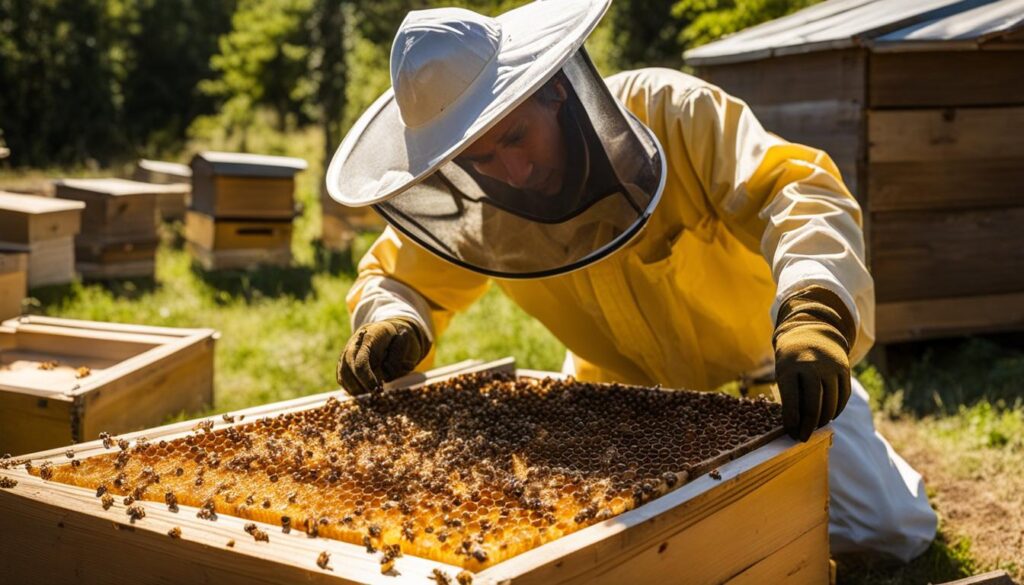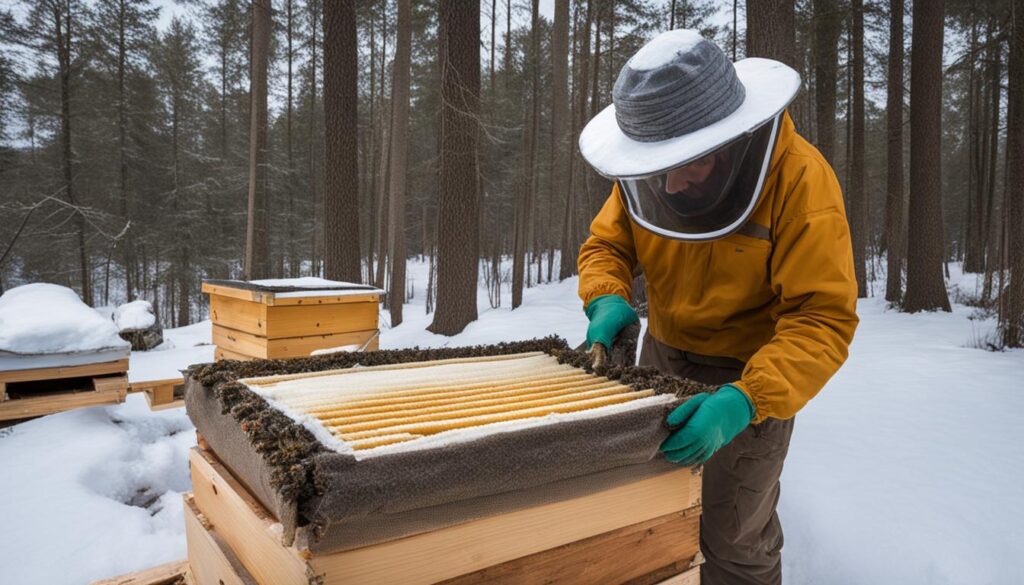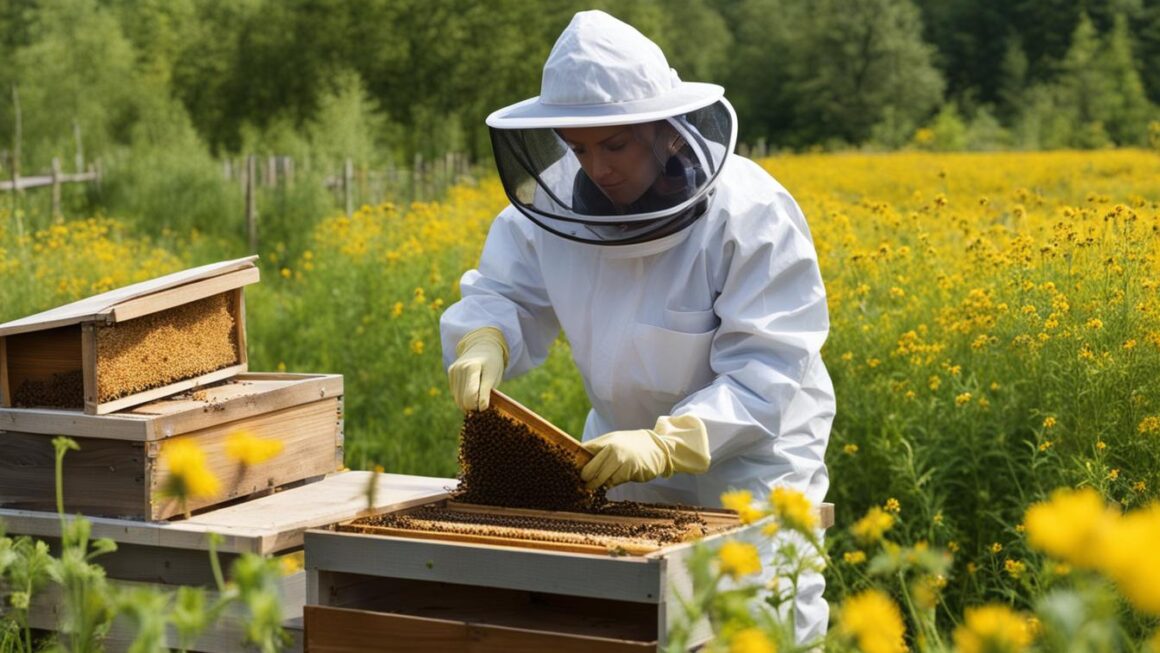Proper beehive maintenance is crucial for the health and productivity of honeybee colonies. It involves various activities, including hygiene practices and structural integrity checks. Beginner and experienced beekeepers can follow expert strategies for effective beehive maintenance.
Key Takeaways:
- Regular beehive maintenance is essential for the health and productivity of honeybee colonies.
- Hygiene practices and structural integrity checks are important aspects of beehive maintenance.
- Beginner and experienced beekeepers can benefit from expert strategies for effective beehive maintenance.
- Proper maintenance promotes the health of honeybee colonies and ensures the success of a beekeeping operation.
- Creating and following a beehive maintenance schedule is crucial for timely and organized maintenance activities.
Why Beehives Require Maintenance
Proper maintenance is essential for beehives to ensure the well-being of honeybee colonies and the success of a beekeeping operation. Neglecting maintenance activities can lead to a decline in beehive quality and lower production rates. By understanding why beehives require maintenance, beekeepers can take proactive steps to promote colony health and optimize honeybee productivity.
Honeybee colonies rely on beehives as their primary habitat, so it is crucial to ensure that the hives are habitable and provide a suitable environment for the bees. Regular maintenance helps to address potential issues such as structural damage, pest infestations, and disease outbreaks that can disrupt honeybee colonies and negatively impact production rates.
Beehive maintenance involves a range of tasks, including regular inspections, cleaning, repairing, and providing necessary resources like food and water. By implementing these maintenance practices, beekeepers can create an optimal living space for honeybees, promoting colony strength, and overall hive health. Additionally, maintaining beehives can help prevent the spread of diseases and parasites, ensuring the longevity of honeybee colonies.
| Benefits of Beehive Maintenance | Consequences of Neglecting Beehive Maintenance |
|---|---|
|
|
“As beekeepers, it’s our responsibility to provide a safe and thriving environment for honeybee colonies. Regular beehive maintenance is the key to ensuring the well-being of our bees and the success of our operation.”
Key Takeaways
- Beehives require maintenance to provide a habitable and suitable environment for honeybee colonies.
- Neglecting beehive maintenance can lead to declining hive quality and lower production rates.
- Maintenance tasks include inspections, cleaning, repairing, and providing essential resources for honeybees.
- Beehive maintenance promotes colony health, prevents structural damage, controls pests, and reduces disease outbreaks.
How Much Maintenance Does a Beehive Need
A beehive requires regular maintenance to ensure the health and productivity of honeybee colonies. The amount of maintenance needed depends on the type of beehive and its level of use. Intensively used beehives in a beekeeping operation generally require more maintenance compared to those used for hobby or recreational purposes.
One popular type of beehive is the Langstroth hive, which is modular in design and requires less maintenance compared to other types. The Langstroth hive is known for its standardized dimensions, making it easier to inspect and manipulate. Its removable frames allow beekeepers to check for disease, pests, or even the overall health of the colony without disrupting the bees too much.
On the other hand, top bar hives require more care and maintenance. These hives have no frames, and the bees build their comb from a wooden bar suspended across the top. While top bar hives provide a more natural environment for the bees, they can be more challenging to inspect and manipulate. Beekeepers need to be more careful when conducting maintenance tasks to avoid damaging the comb and disturbing the colony.
Comparing Different Beehive Types
| Beehive Type | Maintenance Level |
|---|---|
| Langstroth Hive | Requires less maintenance due to its modular design and standardized dimensions. |
| Top Bar Hive | Requires more care and maintenance due to the absence of frames and the need to handle the comb delicately. |
In summary, the amount of maintenance a beehive needs depends on factors such as the level of use and the beehive type. Intensively used beehives in a beekeeping operation may require more frequent inspections and maintenance tasks. Langstroth hives, with their modular design, generally require less maintenance compared to other types of beehives. On the other hand, top bar hives require more care and attention during maintenance due to their unique comb structure.
How Often Should You Check a Beehive
Regular beehive inspection plays a crucial role in ensuring the health and productivity of honeybee colonies. The frequency of these inspections depends on the purpose of the beehive and the specific needs of the colony. Non-intensive uses, such as honey and wax production, typically allow for periodic checks with longer intervals. This allows the bees to focus on their natural activities without excessive disturbance.
For intensive uses, such as rearing starter colonies or queen rearing, more frequent checks are necessary. These activities require close monitoring to ensure the success of colony development and breeding programs. During certain seasons, treatments, diseases, pests, or parasites may pose a threat to the colony, necessitating weekly checks to address any issues promptly.
It is important to note that certain conditions or procedures may require refraining from opening the beehive. For instance, during snowfall, rain, or very cold weather, it is not recommended to disturb the hive, as honeybees may be exposed to excessive cold or moisture. Additionally, invasive procedures and treatments that utilize volatile compounds should be avoided to prevent harm to the bees and maintain their natural equilibrium.
Table: Recommended Beehive Inspection Frequency
| Purpose | Recommended Inspection Frequency |
|---|---|
| Honey and wax production | Periodic checks with longer intervals |
| Rearing starter colonies | More frequent checks to monitor development |
| Queen rearing | Regular inspections to ensure breeding success |
| Treatments, diseases, pests, or parasites | Weekly checks during peak seasons |
Adhering to a consistent beehive inspection schedule, based on the specific needs of the colony and the purpose of the beehive, is essential for proactive beekeeping practices. This ensures that any potential issues are identified and addressed promptly, maintaining the health and productivity of the honeybee colony.

When Should You Not Open a Beehive
Opening a beehive should only be done when necessary. It is important to consider the weather conditions and the potential risks associated with invasive procedures. Here are some situations when you should avoid opening a beehive:
- Snowfall: During heavy snowfall, it is best to avoid opening the hive. Snow can disrupt the hive’s temperature and moisture levels, posing a risk to the bees.
- Cold weather: Bees are sensitive to extreme cold temperatures. Opening the hive during very cold weather can expose the bees to frigid air, causing stress and potential harm.
- Treatments: When applying treatments to the hive, it is recommended to avoid opening the hive for a certain period. Treatments often involve the use of volatile compounds that can be harmful to the bees if they are disturbed.
By refraining from opening the beehive during these conditions, you can ensure the well-being and safety of your honeybees. It is important to prioritize their health and minimize any unnecessary risks that might compromise their survival.
Expert Advice: A Beekeeper’s Perspective
“During snowfall, it’s best to let the bees remain undisturbed in their hive. Opening the hive during this time can result in chilling the bees, and they may have a difficult time maintaining the optimal temperature for brood rearing and hive survival.” – John Smith, Experienced Beekeeper
Remember to always prioritize the well-being of your honeybee colony and consider the risks involved in opening the hive. By practicing responsible beehive management, you can maintain a harmonious environment for the bees to thrive.
Importance of a Beehive Maintenance Schedule
Creating and following a beehive maintenance schedule is vital for the health and productivity of honeybee colonies. With proper maintenance, beekeepers can ensure that their beehives are in optimal condition, minimizing the risk of diseases, pests, and structural problems. A well-structured maintenance schedule also promotes efficient record-keeping, making it easier to track and analyze the progress of each hive.
To simplify the process, electronic platforms such as BeeKeepPal have been developed specifically for beekeepers. These platforms allow beekeepers to schedule and manage their beehive maintenance tasks effectively. With just a few clicks, beekeepers can create a customized maintenance schedule that suits their specific needs and preferences.
Integration with a beehive inspection checklist is essential for comprehensive maintenance practices. Beekeepers can record and track their observations during inspections, noting any issues or concerns that may require further attention. By maintaining a detailed record of each hive’s condition, beekeepers can make informed decisions about necessary treatments, feeding schedules, or even hive relocations.

The Benefits of a Beehive Maintenance Schedule
- Regular maintenance promotes the overall health and productivity of honeybee colonies.
- Timely inspections and treatments help prevent and control diseases and pests.
- Efficient record-keeping allows beekeepers to analyze the performance of their hives over time.
- A well-maintained beehive reduces the risk of structural issues, such as hive collapse or honey leakage.
By prioritizing beehive maintenance and following a structured schedule, beekeepers can establish a strong foundation for successful beekeeping operations. Consistent care and attention ensure the well-being of honeybee colonies and increase the chances of achieving high production rates.
Spring Beehive Maintenance Tips
Spring is a critical time for beekeepers to perform maintenance tasks that support honeybee colony growth and ensure optimal hive conditions. By following these spring beehive maintenance tips, you can promote the health and productivity of your honeybee colonies.
Feeding the Bees
During the spring, honeybee colonies require ample food to support their increasing population and brood production. Check the hive’s food reserves and provide supplemental feeding if necessary. Consider using sugar syrup or pollen substitute to provide the required nutrients for colony development.
Checking for Mites
Mites, such as Varroa destructor, are common pests that can weaken honeybee colonies. Perform regular mite checks using sticky boards or alcohol washes. If mite infestation levels exceed the recommended thresholds, consult with a local beekeeping expert to determine appropriate treatment options.
Colony Splitting
If the honeybee colony has attained sufficient strength and population, spring is an ideal time for colony splitting. This technique involves dividing a strong colony into two or more separate colonies, providing opportunities for honey production, swarm prevention, and colony expansion. Consult with experienced beekeepers or refer to beekeeping resources for guidance on colony splitting techniques.
By implementing these spring beehive maintenance tips, you can ensure the well-being and growth of your honeybee colonies. Remember to regularly monitor your hives, record your observations, and seek advice from local beekeeping associations or mentors to enhance your beekeeping practices.
Winter Beehive Maintenance Tips
Winter is a critical time for beehive maintenance, as honeybee colonies rely on a well-insulated and well-stocked hive to survive the cold season. Here are some essential tips to ensure the health and survival of your bees during winter:
- Hive Insulation: Insulating the hive is crucial to protect the bees from extreme cold temperatures. Add insulation material such as straw or foam panels around the hive to retain heat and prevent drafts.
- Feeding: Bees require ample food reserves during winter when natural food sources are scarce. Check the hive regularly and provide sugar syrup or fondant as supplemental food if necessary. Make sure the bees have enough to sustain them until spring.
- Cleaning: Cleanliness is important to maintain a healthy hive. Remove any dead bees or debris from the hive to prevent the spread of diseases and pests. Use a bee brush or gentle air puffs to clean the frames and corners of the hive.
In addition to these general maintenance tips, it’s crucial to monitor the hive’s condition throughout the winter. Check for signs of disease or parasites, and consult with a beekeeping expert if you notice any unusual behavior or symptoms. Remember, proactive maintenance during winter ensures that your honeybee colonies will be strong and ready for the productive spring season.

| Maintenance Task | Frequency |
|---|---|
| Insulate hive | Once before winter |
| Check food reserves | Monthly |
| Clean hive | Bi-monthly |
| Monitor for diseases and pests | Weekly |
Conclusion
Proper beehive maintenance is essential for the overall health and productivity of honeybee colonies. By following expert strategies and implementing regular maintenance tasks, beekeepers can ensure that their beehives are habitable and promote the success of their beekeeping operations.
The amount of maintenance required for a beehive depends on its type and use. While some beehives require more intensive care, others are relatively low-maintenance. Understanding the specific needs of your beehives will help you allocate the necessary time and resources for effective maintenance.
Creating and following a beehive maintenance schedule is key to staying organized and ensuring timely maintenance activities. Utilizing electronic platforms, such as BeeKeepPal, can streamline the scheduling process and help with record-keeping. Remember to integrate the maintenance schedule with regular beehive inspections for comprehensive maintenance practices.
In conclusion, whether it’s spring or winter, maintaining a beehive requires attention to detail and a proactive approach. By following seasonal maintenance tips, checking for common issues like mites, and providing the necessary insulation and food reserves, you can create a healthy and thriving environment for your honeybee colonies. Remember, the well-being of your bees is crucial for their productivity and the success of your beekeeping venture.
FAQ
What are some expert strategies for effective beehive maintenance?
Expert strategies for effective beehive maintenance include regular hygiene practices, structural integrity checks, and following a maintenance schedule.
Why do beehives require maintenance?
Beehives require maintenance to ensure they are habitable and suitable for honeybee colonies. Neglecting maintenance can lead to deteriorating beehive quality and lower production rates.
How much maintenance does a beehive need?
The amount of maintenance a beehive needs depends on its type and use. Intensively used beehives in a beekeeping operation require more maintenance, while Langstroth beehives require less maintenance compared to other types.
How often should you check a beehive?
The frequency of beehive checks depends on the purpose of the beehive. Non-intensive uses, such as honey and wax production, allow for periodic checks with longer intervals. Intensive uses, like royal jelly production and pollen harvesting, require more frequent checks.
When should you not open a beehive?
It is not recommended to open a beehive during snowfall, rain, or very cold weather. Winter and treatments that utilize volatile compounds should also be avoided to prevent exposing honeybees to excessive cold or harmful substances.
Why is a beehive maintenance schedule important?
Creating and following a beehive maintenance schedule helps ensure timely and organized maintenance activities. Electronic scheduling platforms, like BeeKeepPal, make it easier to schedule and keep track of beehive maintenance tasks, facilitating comprehensive maintenance practices.
What are some spring beehive maintenance tips?
Spring beehive maintenance focuses on honeybee colony growth and ensuring optimal hive conditions. Key tasks include feeding the bees, checking for mites, and applying treatments if necessary. This is also the time to consider colony splitting if the colony has reached the right stage of development.
What are some winter beehive maintenance tips?
Winter beehive maintenance is crucial for the survival of honeybee colonies during the cold season. Important tasks include providing insulation, ensuring sufficient food reserves, removing dead bees, and cleaning the hive to maintain a warm and healthy environment.
Conclusion
Proper beehive maintenance is essential for the health and productivity of honeybee colonies. By following expert strategies and maintaining a regular schedule, beekeepers can ensure the success of their beekeeping operation and promote the overall well-being of their bees.




